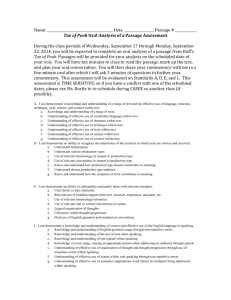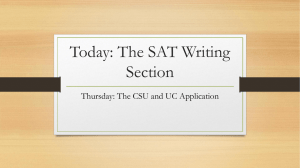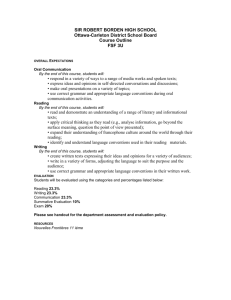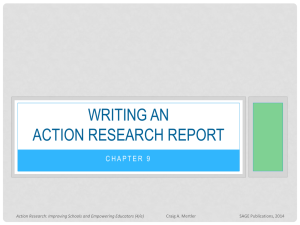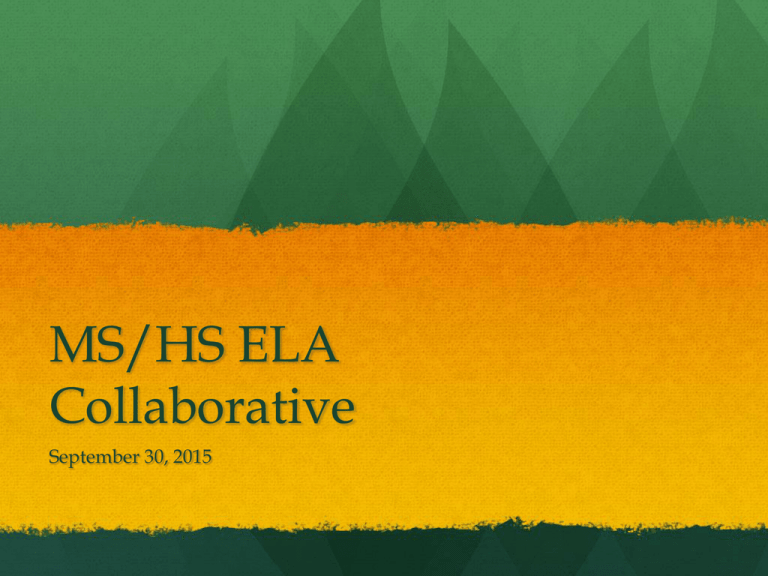
MS/HS ELA
Collaborative
September 30, 2015
What’s your metaphor?
Learning Targets
Working Agreements
“There is a calamitous,
universal falling off of
reading that occurs around
the age of__________.”
“We can’t solve problems by using the same
kind of thinking we used to create them.”
Albert Einstein
Moving Beyond the 4X4
Classroom
Book Study
Chapter 1
Inquiry Question
What are you learning about
what is in the best interest
of our students?
Chapter 2: Staying True to What
Works in the Teaching of Reading
What does the text say?
Summarization Activities
Write a Headline
Guess the Headline!
Window Quotes
Digital Text Summaries
What Does the Text Do?
Reading like a Writer
What does the text mean?
Reading Between the Lines
Close Reading
Chapter 3: Where the Common Core
Reading Standards Fall Short
Lunch
SAT/PSAT
PROFESSIONAL
DEVELOPMENT
MODULE
3
The Redesigned SAT –
Expression of Ideas
Standard English Conventions
© 2015 The College Board
Professional Development
Modules for the Redesigned SAT
Module 1
Key Changes
Module 2
Words in Context and Command of Evidence
Module 3
Expression of Ideas and Standard English Conventions
Module 4
Math that Matters Most:
Heart of Algebra
Problem Solving and Data Analysis
Module 5
Math that Matters Most:
Passport to Advanced Math
Additional Topics in Math
Module 6
Using Assessment Data to Inform Instruction
34
© 2015 The College Board
Writing and Language
Test Content Specifications
SAT WRITING AND LANGUAGE TEST CONTENT SPECIFICATIONS
NUMBER
1. Use the Test
Specifications- SAT
Writing and
Language Test.
PERCENTAGE OF TEST
Time Allotted
35 minutes
Passage Word Count
1700 words total from 4 passages; 400–450 words per passage
Total Questions
44 questions
100%
Multiple Choice (4 options)
100%
Passage Based
100%
Contribution of Items to Subscores and Scores
2. Discuss: What are
the top 3-5 things
everyone needs to
know in the Writing
and Language Test
Specifications?
3. Be prepared to
share findings with
the group.
Expression of Ideas
24 questions
55%
Standard English Conventions
20 questions
45%
Words in Context
(Across Reading and Writing and Language Tests)
8 questions
(2 questions per passage)
18%
Command of Evidence
(Across Reading and Writing and Language Tests)
8 questions
(2 questions per passage)
18%
Analysis in History/Social Studies
6 questions (all Expression of Ideas
(Across Math, Reading, and Writing and Language Tests) questions in history/social studies)
14%
Analysis in Science
6 questions (all Expression of Ideas
(Across Math, Reading, and Writing and Language Tests) questions in science)
14%
Passage Contents
Careers
1 passage; 11 questions
25%
History/Social Studies
1 passage; 11 questions
25%
Humanities
1 passage; 11 questions
25%
Science
1 passage; 11 questions
25%
35
© 2015 The College Board
Expression of Ideas and
Standard English Conventions
Writing and Language Test
36
© 2015 The College Board
Expression of Ideas
► Students will revise and edit extended texts across a range of academic and
career-related subjects
-
show facility with a core set of grammar, usage, and punctuation conventions
► Questions focus on revision of text:
-
topic development
-
accuracy (consistency between text and graphic[s])
-
logic
-
cohesion
-
rhetorically effective use of language.
► Some Passages are based in science and history/social studies
-
These passages contribute to Analysis in Science and Analysis in History/Social
Studies Cross-Test Scores
37
© 2015 The College Board
Standard English Conventions
► Students will read a passage, and then answer questions about what corrections
are needed (if any) pertaining to:
-
Sentence structure: questions focus on editing text to correct problems in sentence
formation and inappropriate shifts in construction within and between sentences.
-
Conventions of Usage: questions focus on editing text to ensure conformity to the
conventions of standard written English usage.
-
Conventions of Punctuation: questions focus on editing text to ensure conformity to
the conventions of standard written English punctuation.
38
© 2015 The College Board
How Do The Tests Impact
Instruction in Science, Social Studies, and CareerRelated Courses?
► Cross-test scores will include a score for Analysis in Science and Analysis in
History/Social Studies
-
Texts used for analysis on the Writing and Language Test will have foundations in
content area courses
-
Tables, graphs, and data used on all tests will relate to topics in content
areas.Tables, graphs, and data may relate to topics in content areas
► Some Expression of Ideas questions will contribute to Analysis in History/Social
Studies and Analysis in Science Cross-Test Scores
39
© 2015 The College Board
Writing and Language Test Experience
© 2015 The College Board
Instructional Strategies
► Use the Brainstorming Instructional Strategies Activity to brainstorm ways to
instruct and assess Expression of Ideas and Standard English Conventions.
41
© 2015 The College Board
Expression of Ideas –
Instructional Strategies
► Practice writing and language analysis skills to develop student analyses
of social studies, science, and career-related passages. Ask them to focus
on:
-
effective language use
-
expression of ideas
-
properly utilizing standard English conventions
► Using the informational graphics in a textbook or periodical, provide
students with inaccurate interpretations of data and ask them to correct
the error(s). Have them explicitly describe the data they used to make each
correction.
► Revisit and edit previous writing assignments.
42
© 2015 The College Board
Expression of Ideas –
Instructional Strategies
► Practice writing and language analysis skills to develop student analyses
of social studies, science, and career-related passages. Ask them to focus
on:
-
effective language use
-
expression of ideas
-
properly utilizing standard English conventions
► Using the informational graphics in a textbook or periodical, provide
students with inaccurate interpretations of data and ask them to correct
the error(s). Have them explicitly describe the data they used to make each
correction.
► Revisit and edit previous writing assignments.
43
© 2015 The College Board
Follow-Up Activity: Tips for Professional
Learning Communities and Vertical Teams
Professional Learning Community Data Analysis
The “Tips for Professional
Learning Communities and
Vertical Teams” is
available to guide teams of
colleagues in the review
and analysis of SAT
reports and data.
Review the data and make
observations.
Consider all of the observations of
the group. Determine whether the
group discussion should be
focused on gaps, strengths, or
both. Select one or two findings
from the observations to analyze
and discuss further.
Identify content skills associated
with the areas of focus.
Review other sources of data for
additional information.
Develop the action plan.
Goal:
Measure of Success:
Steps:
When you’ll measure:
44
© 2015 The College Board
Self Assessment/Reflection
► How well do you teach skills related to Expression of Ideas?
► How well do you teach skills related to Standard English Conventions?
► What can you do in your classroom immediately to help students understand
what they’ll see on the redesigned SAT?
► What long-term adjustments can you make to support students in developing
their mastery of Expression of Ideas and Standard English Conventions?
► What additional resources do you need to gather in order to support students in
becoming college and career ready?
► How can you help students keep track of their own progress toward meeting the
college and career ready benchmark?
45
© 2015 The College Board
Questions or comments about this
presentation or the SAT redesign?
Email: SATinstructionalsupport@collegeboard.org
46
© 2015 The College Board
Grammar Resources
https://www.noredink.com/for-teachers
www.number2.com
http://www.quickanddirtytips.com/education/gra
mmar/affect-versus-effect
Grammar Keepers
Too
“He has outraged too many wise men and pleased too many fools to hide behind
his too-appropriate pseudonym much longer.”
From Ender’s Game by Orson Scott Card
-
“Rethinking Classroom
Observation”
Three A’s Plus One
Individually:
Read and highlight the text selection
Record on index cards (one “A” per index card):
Agree: One thing with which you agree
Argue: One thing with which you might argue
Aspire: One thing to which you aspire
Groups at Work – Copyright MiraVia LLC – All rights
reserved
Quartets:
•
Three A’s Plus One
Letter off A-D
Round 1:
Share Agreement cards one at a time without
commenting on them; place all four cards on
table
A offers a summarizing paraphrase for cards on
the table
Then, A leads an inquiry with quartet into values
and beliefs associated with their choices
Groups at Work – Copyright MiraVia LLC – All rights
reserved
Three A’s Plus One
Rounds 2 & 3:
Repeat process of sharing cards one at a time
and placing on table
B leads paraphrasing and inquiry for
Argument cards (Round 2)
C leads paraphrasing and inquiry for
Aspiration cards (Round 3)
Groups at Work – Copyright MiraVia LLC – All rights
reserved
Three A’s Plus One
Round 4:
• Individually, record one last card:
“AHA”: A personal insight or new perception
• Share “AHA” cards one at a time without
commenting on them; place on table
• D leads paraphrasing and inquiry for “AHA”
cards
Groups at Work – Copyright MiraVia LLC – All rights
reserved
Peer Observation Process
Closing

